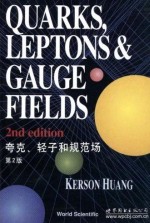- 文学
- 小说
- 艺术
- 古籍善本(国学)
- 动漫绘本
- 生活
- 励志
- 社科
- 经管
- 文化
- 教育
- 幼儿读物
- 体育
- 外语
- 历史
- 地理
- 计算机
- 科技
- 生物
- 医学
- 农林
- 工业
- 综合
- 进口原版

-
《夸克、轻子和规范场(第2版)》简明地介绍了在这些思想背后的动力,以及由此而来的严谨的数学系统表述。依据通行的观点,物质的基本彻块是夸克与轻子,它们通过杨-米尔斯规范场的媒介相互作用(在这种场合下引力被忽...
《夸克、轻子和规范场(第2版)》简明地介绍了在这些思想背后的动力,以及由此而来的严谨的数学系统表述。依据通行的观点,物质的基本彻块是夸克与轻子,它们通过杨-米尔斯规范场的媒介相互作用(在这种场合下引力被忽略了)。这就意味着相互作用的形式是完全由某些内部对称群的代数结构所决定的。于是强相互作用是与SU(3)群相关联的,它是由叫做量子色动力学的规范场理论所描述的。而电一弱相互作用则是与SU(2)XU(1)群相关联的,现在它是由标准的温伯格-萨拉姆模型来描述的。
PREFACE\r\nⅠ.INTRODUCTION\r\n 1.1 Particles and Interactions\r\n 1.2 Gauge Theories of Interactions\r\n 1.3 Notations and Conventions\r\nⅡ.QUARKS\r\n 2.1 Internal Symmetries\r\n 1 Isospin\r\n 2 The gauge groups\r\n 3 More general internal symmetries: SU(n)\r\n 4 Unitary symmetry\r\n 2.2 Representation of SU(3)\r\n 1 The basic representation\r\n 2 Young\'s tableaux\r\n 3 Irreducible representations\r\n 2.3 The Quark Model\r\n 1 Quarks as basic triplets\r\n 2 Quarks as building blocks\r\n 3 Weight diagrams\r\n 4 The composition of hadrons\r\n 2.4 Color\r\n 1 Independent quark model\r\n 2 Color SU(3) group\r\n 2.5 Electromagnetic and Weak Probes\r\n 1 Electromagnetic interactions\r\n 2 Parton model\r\n 3 Evidence for color\r\n 4 Weak interactions\r\n 2.6 Charm\r\n 1 The charmed quark\r\n 2 The J/φ and its family\r\n 3 Correspondence between quarks and leptons\r\nⅢ.MAXWELL FIELD: U(I) GAUGE THEORY\r\n 3.1 Global and Local Gauge Invariance\r\n 3.2 Spontaneous Breaking of Global Gauge Invariance: Goldstone Mode\r\n 3.3 Spontaneous Breaking of Local Gauge Invariance: Higgs Mode\r\n 3.4 Classical Finite-Energy Solutions\r\n 3.5 Magnetic Flux Quantization\r\n 3.6 Soliton Solutions: Vortex Lines\r\nⅣ. YANG-MILLS FIELDS: NON-ABELIAN GAUGE THEORIES\r\n 4.1 Introductory Note\r\n 4.2 Lie Groups\r\n 1 Structure constants\r\n 2 Matrix representations\r\n 3 Topological properties\r\n 4 General remarks\r\n 4.3 The Yang-Mills Constructions\r\n 1 Global gauge invariance\r\n 2 Local gauge invariance\r\n 4.4 Properties of Yang-Milis Fields\r\n 1 Electric and magnetic fields\r\n 2 Dual tensor\r\n 3 Path representation of the gauge group\r\n 4.5 Canonical Formalism\r\n 1 Equations of motion\r\n 2 Hamiltonian\r\n 4.6 Spontaneous Symmetry Breaking\r\n 1 The little group\r\n 2 Higgs mechanism\r\nⅤ.TOPOLOGICAL SOLITONS\r\n 5.1 Solitons\r\n 5.2 The Instanton\r\n 1 Topological charge\r\n 2 Explicit solution\r\n 5.3 The Monopole\r\n 1 Topological stability\r\n 2 Flux quantization\r\n 3 Boundary conditions\r\n 4 Explicit solution\r\n 5 Physical fields\r\n 6 Spin from isospin\r\nⅥ.WEINBERG-SALAM MODEL\r\n 6.1 The Matter Fields\r\n 6.2 The Gauge Fields\r\n 1 Gauging SU(2)×U(1)\r\n 2 Determination of constants\r\n 3 Interactions\r\n 6.3 The General Theory\r\n 1 Mass terms\r\n 2 Cabibbo angle\r\n 3 Kobayashi-Maskawa matrix\r\n 4 Solitons\r\nⅦ.METHOD OF PATH INTEGRALS\r\n 7.1 Non-Relativistic Quantum Mechanics\r\n 7.2 Quantum Field Theory\r\n 7.3 External Sources\r\n 7.4 Euclidean 4-Space\r\n 7.5 Calculation of Path Integrals\r\n 7.6 The Feynman .Propagator\r\n 7.7 Feynman Graphs\r\n 7.8 Boson Loops and Fermion Loops\r\n 7.9 Fermion Fields\r\nⅧ.QUANTIZATION OF GAUGE FIELDS\r\n 8.1 Canonical Quantization\r\n 1 Free Maxwell field\r\n 2 Pure Yang-Mills fields\r\n 8.2 Path Integral Method in Hamiltonian Form\r\n 8.3 Feynman Path Integral: Fadeev-Popov Method\r\n 8.4 Free Maxwell Field\r\n 1 Lorentz gauge\r\n 2 Coulomb gauge\r\n 3 Temporal and axial gauges\r\n 8.5 Pure Yang-Mills Fields\r\n I Axial gauge\r\n 2 Lorentz gauge: Fadeev-Popov ghosts\r\n 8.6 The 0-World and the Instanton\r\n 1 Discovering the 0-world\r\n 2 lnstanton as tunneling solution\r\n 3 The 0-action\r\n 8.7 Gribov Ambiguity\r\n 8.8 Projection Operator for Gauss\' Law\r\nⅨ.RENORMALIZATION\r\n 9.1 Charge Renormalization\r\n 9.2 Perturbative Renormalization in Quantum Electredynamics\r\n 9.3 The Renormalization Group\r\n 1 Scale transformations\r\n 2 Scaling form\r\n 3 Fixed points\r\n 4 Callan-Symanzik equation\r\n 9.4 Scalar Fields\r\n 1 Renormalizability\r\n 2 Φ4 theory\r\n 3 \"Triviality\" and the Landau ghost\r\n 9.5 The Physics of Renormalization\r\n 1 Renormalization-group transformation\r\n 2 Real-space renormalization\r\n 3 Fixed points and relevancy\r\n 4 Renormalization and universality\r\n Appendix to Chapter 9. Renormalization of QED\r\n 1 Vertex\r\n 2 Electron Propagator\r\n 3 Photon Propagator\r\n 4 Scaling Properties\r\n 5 Renormalization\r\n 6 Gauge Invariance and the Photon Mass\r\nⅩ.METHOD OF EFFECTIVE POTENTIAL\r\n 10.1 Spontaneous Symmetry Breaking\r\n 10.2 The Effective Action\r\n 10.3 The Effective Potential\r\n 10.4 The Loop Expansion\r\n 10.5 One-Loop Effective Potential\r\n 10.6 Renormalization\r\n 1 General scheme\r\n 2 Massive case\r\n 3 Massless case\r\n 10.7 Dimensional Transmutation\r\n 10.8 A Non-Relativistic Example\r\n 10.9 Application to Weinberg-Salam Model\r\nⅪ. THE AXIAL ANOMALY\r\n 11.1 Origin of the Axial Anomaly\r\n 11.2 The Triangle Graph\r\n 11.3 Anomalous Divergence of the Chiral Current\r\n 11.4 Physical Explanation of the Axial Anomaly\r\n 11.5 Cancellation of Anomalies\r\n 11.6 \'t Hooft\'s Principle\r\nⅫ. QUANTUM CHROMODYNAMICS\r\n 12.1 General Properties\r\n 1 Lagrangian density\r\n 2 Feynman rules\r\n 3 Quark-gluon interactions\r\n 4 Gluon self-interactions\r\n 12.2 The Color Gyromagnetic Ratio\r\n 12.3 Asymptotic Freedom\r\n 1 The running coupling constant\r\n 2 The vacuum as magnetic medium\r\n 3 The Nielsen-Hughes formula\r\n 12.4 The Pion as Goldstone Boson\r\n 1 The low-energy domain\r\n 2 Chiral symmetry: an idealized limit\r\n 3 PCAC\r\n 4 The decay π0→2y\r\n 5 Extension to pion octet\r\n 12.5 The U(1) Puzzle\r\n 12.6 θ-Worlds in QCD\r\n 1 Euclidean action\r\n 2 The axial anomaly and the index theorem\r\n 3 Chiral limit: Collapse of the 0-worlds\r\n 4 Quark mass matrix\r\n 5 Strong CP violation\r\nⅩⅢ. LATTICE GAUGE THEORY\r\n 13.1 Wilson\'s Lattice Action\r\n 13.2 Transfer Matrix\r\n 13.3 Lattice Hamiltonian\r\n 13.4 Lattice Fermions\r\n 13.5 Wilson Loop and Confinement\r\n 13.6 Continuum Limit\r\n 13.7 Monte Carlo Methods\r\nⅩⅣ. QUARK CONFINEMENT\r\n 14.1 Wilson Criterion and Electric Confmement\r\n 14.2 String Model of Hadrons\r\n 14.3 Superconductivity: Magnetic Confinement\r\n 1 Experimental manifestation\r\n 2 Theory\r\n 3 Mechanism for monopole confinement\r\n 14.4 Electric and Magnetic Order Parameters\r\n 14.5 Scenario for Quark Confinement\r\n Appendix to Chapter 14.Symmetry and Confinement\r\n 1 Quark Propagator\r\n 2 Center Symmetry\r\n 3 Confinement as Symmetry\r\n INDEX\r\n







